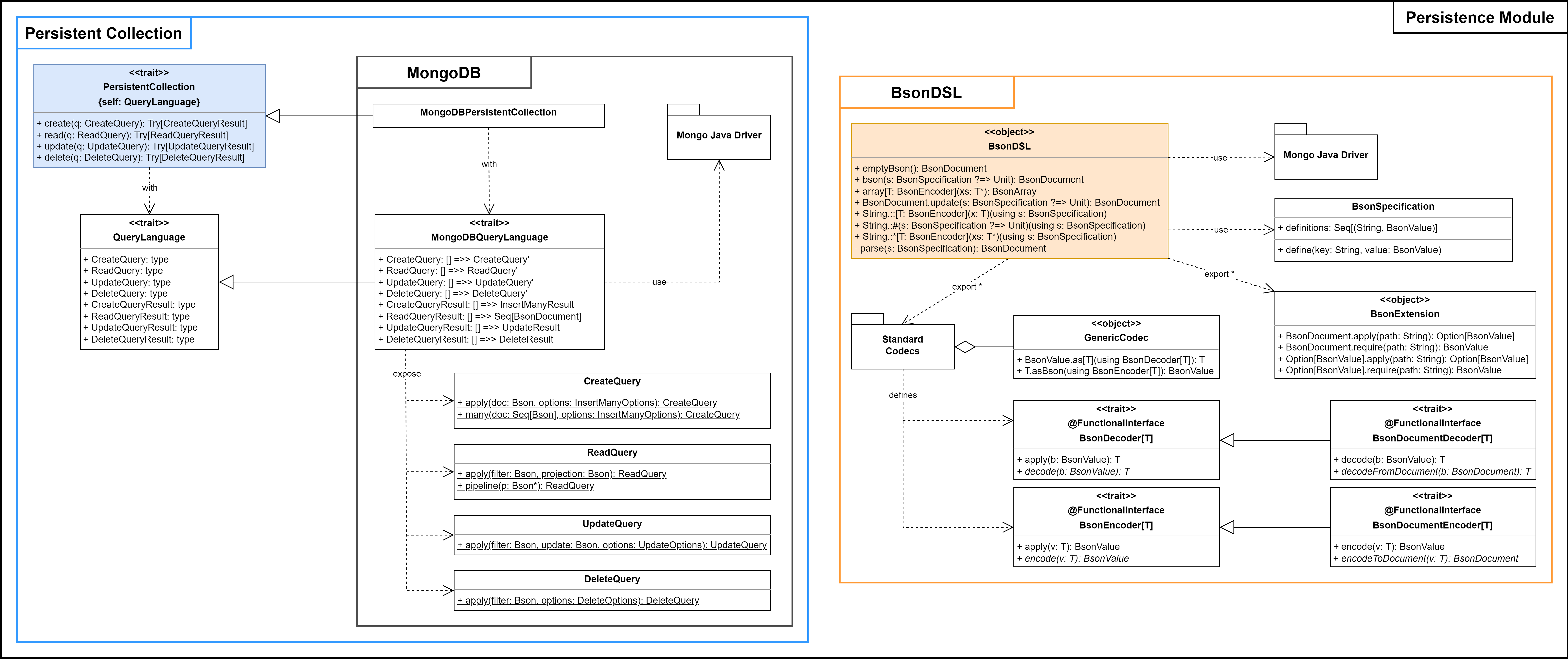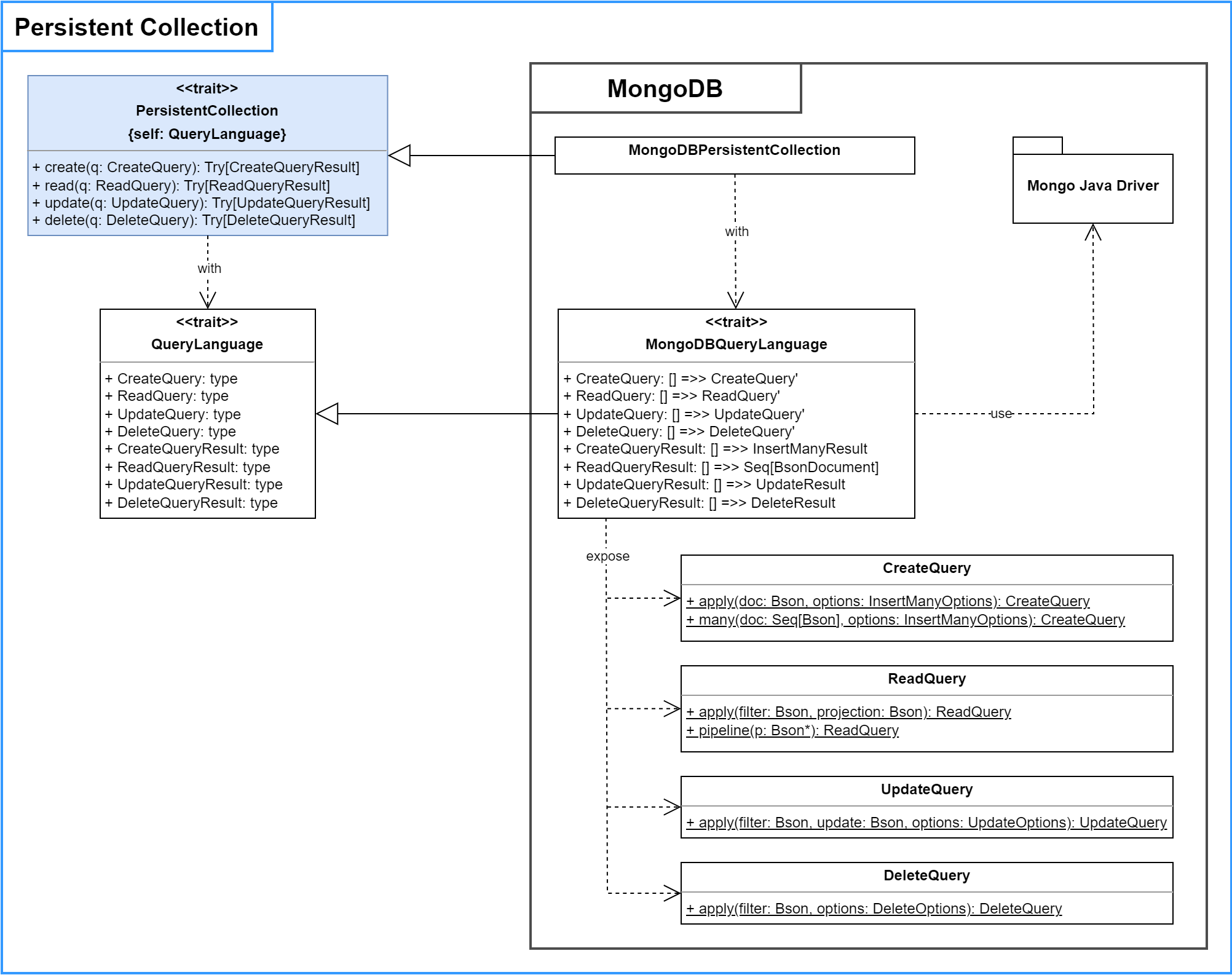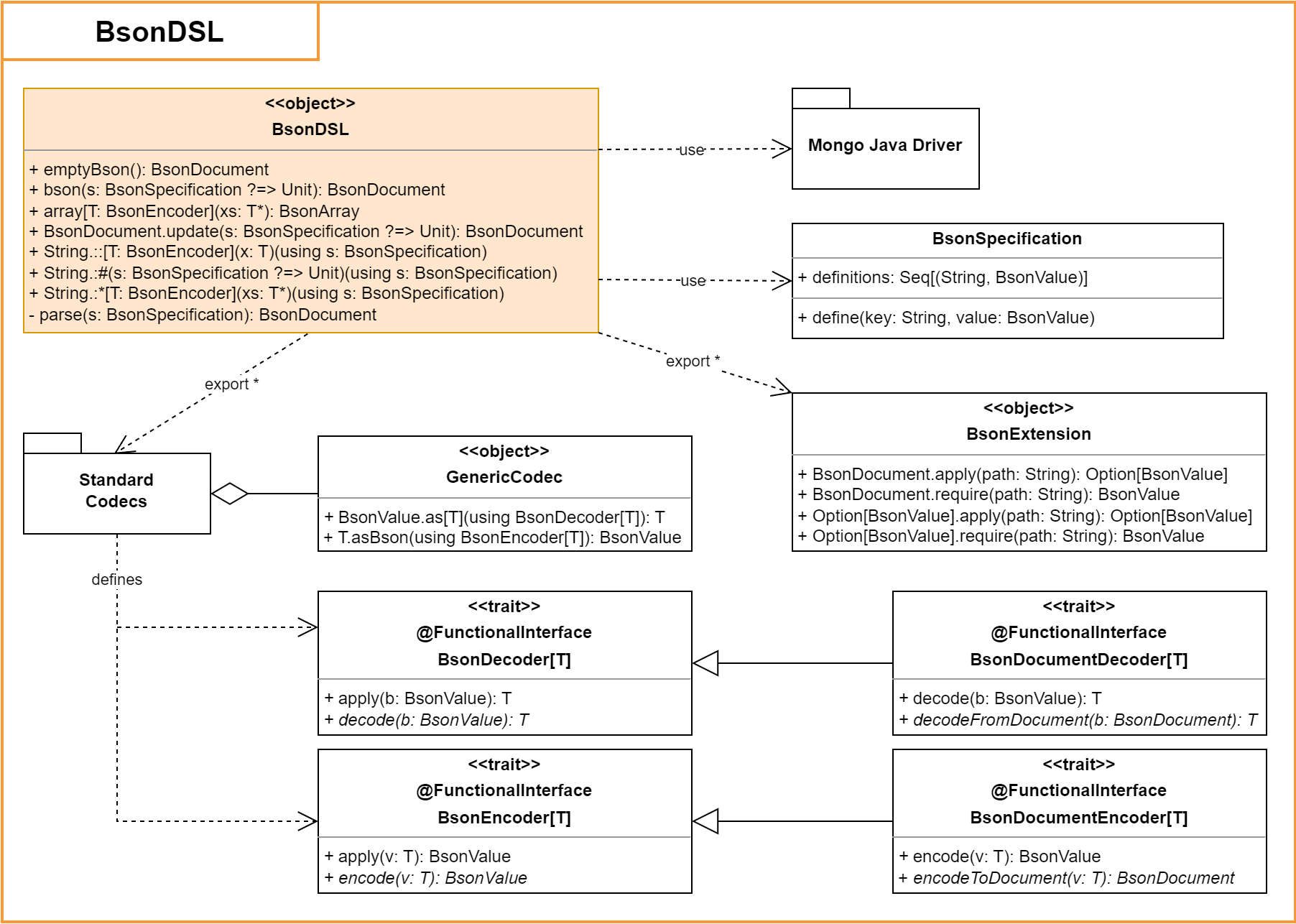Persistence Module
This chapter will delve into the implementation of the Persistence Module within the HexArc framework.
Table of Contents
Implementation
The Persistence Module is a supporting module of the HexArc architecture, providing tools to decouple the business logic of a service from specific persistent storage technologies, often required to maintain a state outside the service lifetime. Moreover, it provides tools to easily manipulate data inside a service.
Below is the complete class diagram of the Persistence Module.

As shown in the diagram, the Persistence Module is made of two main submodules:
- Persistence Collection Submodule: defines the concepts required to decouple a service from its persistent storage;
- BsonDSL Submodule: provides a DSL for working with BSON documents in a declarative way.
Persistent Collection Submodule
The Persistent Collection Submodule is the part of the Persistence Module that defines the concepts required to decouple a service from its persistent storage.
Below is the class diagram of the Persistent Collection Submodule.

The most important concept of the module is the PersistentCollection, which is basically a collection of data which persists over multiple runs of an application.
A PersistentCollection provides four methods corresponding to the CRUD operations, namely:
create: accepts a query for inserting some documents in thePersistentCollection;read: accepts a query for retrieving some documents from thePersistentCollection;update: accepts a query for modifying some documents of thePersistentCollection;delete: accepts a query for removing some documents from thePersistentCollection.
A PersistentCollection relies on a QueryLanguage, which defines the types of query accepted by the operations above, together with the types of result produced by those operations. This relationship is made explicit by using QueryLanguage as a self-type of PersistentCollection, meaning that in order to create a PersistentCollection, a QueryLanguage must always be applied to the PersistentCollection as a mixin (i.e. a PersistentCollection cannot exist without a QueryLanguage).
For each of the CRUD operations, a QueryLanguage defines its input as a query and its output as a query result. That makes a total of eight types, namely: CreateQuery, CreateQueryResult, ReadQuery, ReadQueryResult, UpdateQuery, UpdateQueryResult, DeleteQuery and DeleteQueryResult.
The Persistent Collection Module doesn’t only define the abstract concepts of a persistent storage, but it also provides some built-in implementations already integrated with some of the most used persistent storage technologies (e.g. MongoDB…).
MongoDB Persistent Collection
This section will present the MongoDBPersistentCollection as a sample implementation of a PersistentCollection. The implementation relies on Mongo Java Driver, which already provides the concepts required for interacting with a MongoDB database.
Before implementing a PersistentCollection, its QueryLanguage should be defined. For MongoDB, the QueryLanguage is modelled by the MongoDBQueryLanguage, where queries are defined using BSON documents, which may describe data, filters, projections, updates or more general aggregations inside a query.
The MongoDBQueryLanguage exposes the implementations of the possible queries in MongoDB and the implementations of their results. Some of these implementations were already provided by Mongo Java Driver.
Once the MongoDBQueryLanguage is implemented, it is possible to define a PersistentCollection which depends on it, such as the MongoDBPersistentCollection.
In order to create a MongoDBPersistentCollection, the user must specify a connection string towards a specific collection inside a MongoDB database, basically binding the MongoDBPersistentCollection to that MongoDB collection.
In a MongoDBPersistentCollection, the CRUD operations are implemented by feeding the user’s queries of the MongoDBQueryLanguage to a MongoDBClient, that is connected to the MongoDB collection bound to the MongoDBPersistentCollection, therefore applying the user’s queries to that MongoDB collection.
BsonDSL Submodule
The BsonDSL Submodule is the part of the Persistence Module that defines a DSL for easily manipulating BSON documents, reducing boilerplate code.
Below is the class diagram of the BsonDSL Submodule.

The entrypoint of the module is the DSL, modelled by the object BsonDSL. The BsonDSL depends on the Mongo Java Driver library and provides a functional DSL for creating and updating BsonDocuments (which is the class used by Mongo Java Driver for modelling BSON documents).
In HexArc, the creation of a BsonDocument relies on a BsonSpecification, which is basically a list of the key-value pairs in a BSON document.
The BsonDSL creates a new BsonSpecification each time the user starts creating a new BsonDocument. The BsonSpecification is used internally to keep track of the state of that BsonDocument as the user defines its key-value pairs. Finally, when the user is done, the BsonSpecification is parsed producing the corresponding BsonDocument.
The BsonDSL provides two methods for creating a BsonDocument:
emptyBson: creates a newBsonDocumentwith no entries;bson: creates a newBsonDocumentconfigured by a context function provided as input.
Moreover, it provides a method for creating BsonArrays, called array.
When creating a BsonDocument using the bson method, some extension methods are made available for binding the keys of the BsonDocument to their respective BsonValues, namely:
String.::: binds a string key to aBsonValue, adding the key-value pair to theBsonSpecificationgiven in the context where::is used;String.:#: binds a string key to aBsonDocument, adding the key-value pair to theBsonSpecificationgiven in the context where:#is used;String.:*: binds a string key to aBsonArray, adding the key-value pair to theBsonSpecificationgiven in the context where:*is used.
Since in Mongo Java Driver BsonDocuments and BsonArrays are BsonValues, these last two extension methods are actually redundant. In fact, they are used as a shortcut in the DSL, as demonstrated in the User Documentation.
The problem with :: is that it only accepts BsonValues as values that can be bound to a key in a BsonDocument. For example, to bind a key to a String, it is required to bind the key to a BsonString, which is a subtype of BsonValue, like this:
bson {
"stringField" :: BsonString("stringValue")
}
Instead, it would be nicer if :: could be more general, accepting Strings, Ints and any other type, like this:
bson {
"stringField" :: "stringValue"
"intField" :: 1234
"objectField" :: MyCustomObject()
}
To solve this problem, each key-defining method accepts a given BsonEncoder, which tells how to convert an object into its corresponding BsonValue.
The BsonDSL already exposes a built-in set of standard codecs, providing BsonEncoders and BsonDecoders (the inverse operation of a BsonEncoder) for the most common types used when creating BsonDocuments. In addition to the standard codecs, the user is also able to create codecs for his own custom types, extending the BsonDSL according to his requirements.
Since most types in Scala would be converted into a BsonDocument (instead of a general BsonValue), more specific types of BsonDecoder and BsonEncoder have been provided, namely BsonDocumentDecoder and BsonDocumentEncoder, which handles the conversions of objects from and to BsonDocuments.
Among the standard codecs, the GenericCodec provides two extension methods that allow any object to be converted into its corresponding BsonValue, given a proper BsonEncoder, and a BsonValue to be converted into its corresponding object, given a proper BsonDecoder. These are T.asBson and BsonValue.as[T] respectively.
In addition to the creation of BsonDocuments, the BsonDSL provides an extension method for updating BsonDocuments, called BsonDocument.update, which creates a new BsonDocument by replacing or adding key-value pairs to an existing BsonDocument.
Finally, one last functionality provided by the BsonDSL is the ability to read key-value pairs from existing BsonDocuments. In particular, this functionality is handled within an extension of the DSL, called BsonExtension, which is exposed by the BsonDSL.
The BsonExtension provides two main extension methods that can be used to access the content of a BsonDocument:
BsonDocument.apply: retrieves the value bound to a given key or path in aBsonDocument, where a path is a concatenation of keys separated by dots if theBsonDocumentcontains nested documents. This method is safe, meaning that it returns anOption[BsonValue], taking into account that the given key or path may not be bound to any value.Option[BsonValue].apply: same as above, treating theBsonValueas aBsonDocumentif possible. This method allows the following concatenation syntax for accessing nested key-value pairs:val document: BsonDocument = bson { "field" :# { "nestedField1" :: "value1" "nestedField2" :: "value2" } } val field: Option[BsonValue] = document("field") val nestedField1: Option[BsonValue] = field("nestedField1") val nestedField2: Option[BsonValue] = document("field")("nestedField2")Alternatively, the
BsonExtensionalso supports the following syntax:val nestedField1: Option[BsonValue] = document("field.nestedField1")Although, even if it is more concise, this latter syntax had to be implemented separately, while the former syntax came for free from the interactions within the DSL.
For both classes, similar extension methods exist to avoid working with Options when the user is certain of the content of its BsonDocuments. These are called BsonDocument.require and Option[BsonValue].require.
val nestedField1: BsonValue = document.require("field.nestedField1")
Still, all of these extension methods extract BsonValues from BsonDocuments, while it should be made possible to convert such BsonValue into Strings, Ints or any other type.
Here come into play the aforementioned BsonDecoders and in particular the BsonValue.as[T] method, which enables the following syntax:
val nestedField1: Option[String] = document("field.nestedField1").map(_.as[String])
val nestedField2: String = document.require("field.nestedField2").as[String]